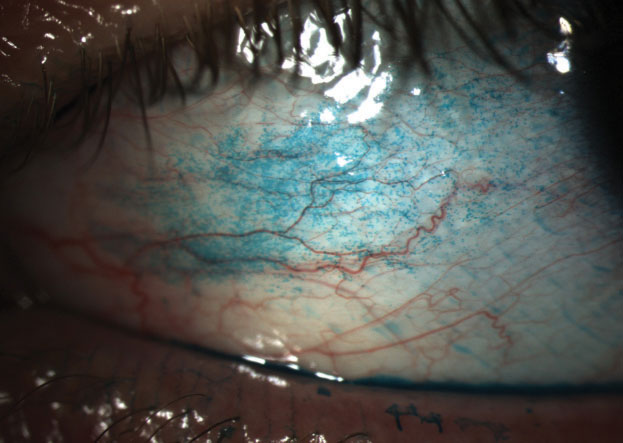 |
|
Patients with gout are more likely to develop dry eye symptoms. Image courtesy of Whitney Hauser, OD. Click image to enlarge. |
Like other inflammatory rheumatic conditions, gout has a negative effect on the ocular surface. In addition to dry eye, it’s also been linked to uveitis, glaucoma, episcleritis, cataracts and red eye caused by conjunctival and episcleral hyperemic vessels. This condition, characterized by elevated levels of uric acid in the blood that deposit as monosodium urate (MSU) crystals in the joints, has increased in prevalence in recent years. It mainly affects men over 40 but may strike women after menopause due to the decrease in estrogen.
Due to the association between gout and dry eye and the rising prevalence of the condition, researchers recently examined tear function in these patients. They used conjunctival impression cytology (CIC), a minimally-invasive biopsy method, to analyze superficial conjunctival epithelial cells.
The study population included 34 patients with gout and 32 age- and sex-matched healthy individuals. Each patient underwent Schirmer 1 testing, tear breakup time (TBUT), Ocular Surface Disease Index (OSDI) scoring and CIC grading (zero through three).
The researchers reported no significant differences between the groups in terms of age and sex. The patients with gout had a significantly lower mean Schirmer 1 test result (9.74mm) than the healthy controls (17.16mm). Their mean TBUT was also significantly lower (seven vs. 12.75 seconds). As expected, the patients with gout scored higher on the OSDI. Their mean score was significantly higher than controls (20.04 vs. 6.19).
In the patients with gout, cytology revealed decreased levels of goblet cell density, indicating poorer ocular surface health as well as early signs of squamous metaplasia. “Goblet cells, which are secretory cells located between the epithelial cell layers, are involved in the secretion of the mucin layer of the tear film,” the researchers explained. “The transformation of nonkeratinized normal conjunctival epithelium [of the conjunctiva] to nonsecretory keratinized squamous epithelium is called squamous metaplasia.”
Findings of conjunctival squamous metaplasia and goblet cell loss increase with CIC grade. Ten patients with gout (29.4%) had CIC grades of two or three, while none of the controls did. Mean CIC in gout patients was 1.15, which was significantly higher than in controls (0.47).
It’s important to consider gout when evaluating patients presenting with dry eye symptoms. “In patients with gout, the accumulation of MSU crystals isn’t limited to joints but is also seen in extra-articular tissues,” the researchers noted. “Accumulation of MSU crystals has been demonstrated in many ocular and periocular tissues.” While the underlying pathophysiology of crystal accumulation in ocular tissues isn’t fully known, researchers believe it may be due to the low solvent ability of ocular structures for MSU. Lower temperatures may also play a role.
The researchers concluded that patients with gout demonstrated greater ocular surface alterations, including dry eye symptoms. “Because studies on ocular surface findings in patients with gout are limited, the awareness of clinicians on this issue should be increased,” they wrote. “Early detection and treatment of ocular surface damage and dry eye is critical and requires a multidisciplinary approach.”
Belviranli S, Turk HB, Oltulu P, et al. Tear function alterations and conjunctival impression cytology findings in patients with gout. Eye Contact Lens. August 20, 2021. [Epub ahead of print]. |


